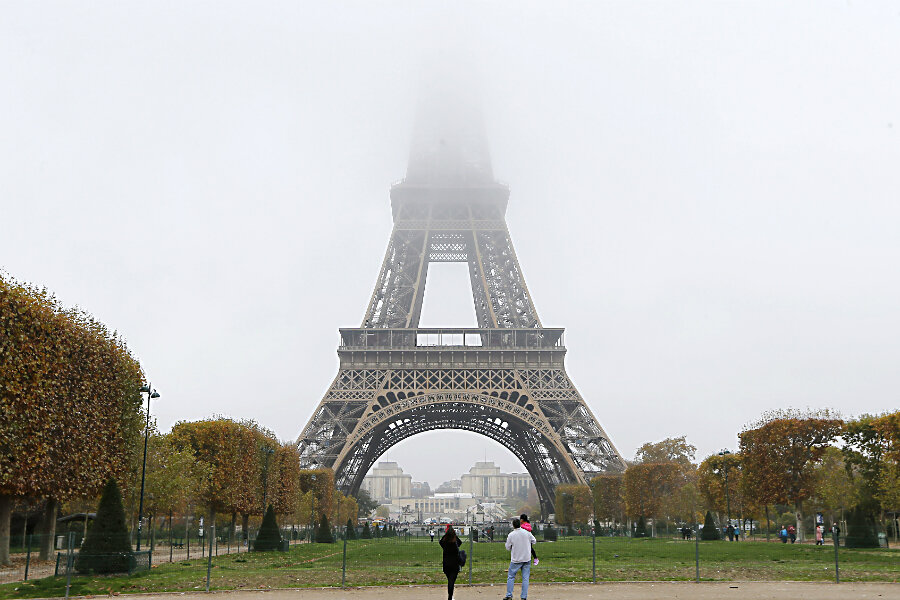Paris climate summit: What to expect from historic talks
Loading...
Negotiators from 195 countries are set to meet in Paris for two weeks, beginning Nov. 30, to wrap up a new, historic pact to limit global warming. A committed group-effort approach replaces top-down strategies that haven’t worked.
Q: What makes this agreement historic?
For the first time, nearly all countries are committing to some level of action, eroding a long-standing divide between developed and developing countries. To get there, however, negotiators jettisoned specific targets on greenhouse gas emissions imposed in a binding treaty. Those targets have been replaced by an overall goal countries have accepted: to hold global warming to no more than 2 degrees C (3.6 degrees F.) by 2100. Each country will determine its own approaches and how much it can contribute to curbing emissions – through cuts or a reduction in the growth rate of emissions – that, collectively, would put the world on the 2-degree path.
These commitments have deadlines of 2030, and in some cases 2025. They represent the first step in a process that would lead to periodic reviews and intensification of these efforts until atmospheric concentrations of greenhouse gases, mainly carbon dioxide from burning fossil fuel, are stabilized at a level that holds warming to 2 degrees C.
Q: What do the commitments look like?
More than 150 countries have submitted “intended nationally determined commitments” (INDCs), according to Christiana Figueres, executive secretary of the United Nations Framework Convention on Climate Change. These countries represent about 90 percent of global emissions. The commitments vary in ambition. Each country sets its own baseline against which it gauges progress. And some commitments are contingent on receiving financial help.
China has pledged to slow the growth in its CO2 emissions so that they peak around 2030. That includes a pledge to increase the share of electricity generated by renewable and nuclear sources to 20 percent by 2030. The United States has pledged to cut carbon emissions to at least 26 to 28 percent below 2005 levels by 2025. Others, such as Ethiopia and Guatemala, use “business as usual” projections as their baselines and hold part or all of their emissions pledges contingent on receiving aid to pay for green energy technologies and for adaptation.
Q: What effect will these have on global warming?
These commitments represent an encouraging shift away from business as usual. But if they all are fully implemented and nothing more is done in the interim, they will have placed the planet on a path to warming around 3 degrees C (5.4 degrees F.) by 2030 rather than 2 degrees. The draft agreement recognizes this, however. It envisions regular reviews aimed at assessing progress and intensifying efforts. If the reviews are set up at five-year intervals, as some expect, the first would come in 2020.
Q: What gives people hope that this will work?
Climate policy specialists cite several factors. One of the most important is a change in attitude. Strategies that once seemed burdensome are increasingly seen as economic opportunities, notes Taryn Fransen, a climate policy specialist with the World Resources Institute in Washington who leads an international collaboration tracking the INDCs and efforts to fulfill them. In addition, over time countries have become more aware of how global warming is affecting them. And renewable technologies are taking hold faster than many had predicted, a pace many models don’t incorporate.
Still, that growth may not be enough, others argue. The UN’s Intergovernmental Panel on Climate Change has noted that to hold warming to 2 degrees C by 2100, countries will need two more arrows in their quivers: the use of bioenergy combined with trapping the CO2 emissions and sequestering that carbon underground. Both are controversial and, for now, neither is available on a large scale.
Q: What are the remaining hurdles to the agreement?
One critical element is money: How much financing will be forthcoming for developing countries, and what sort of compensation might there be for loss and damage? Developing countries still have doubts about the credibility of past commitments from rich countries to increase access to financing for climate-related projects. In 2009, rich nations pledged $100 billion by 2020. Even when that is met, questions remain about what follows. Developing countries are looking for language that indicates this help will continue and increase.
On loss and damage, the US, for instance, is working to ensure that the agreement has no language that implies open-ended liability on the part of developed countries for the damage global warming inflicts on developing countries. That issue may await the final week of the talks to get sorted out, notes Alden Meyer, with the Union of Concerned Scientists in Washington. Another issue is the gap between the commitments and emissions reductions needed to put the planet on the 2-degree C path and how that will be addressed. Provisions for some sort of review process will come out of the talks, Mr. Meyer says.“But how they are couched and how effective they will be, and whether they really create an opening to stand back and look at this again in four or five years – that’s a question,” he says.








